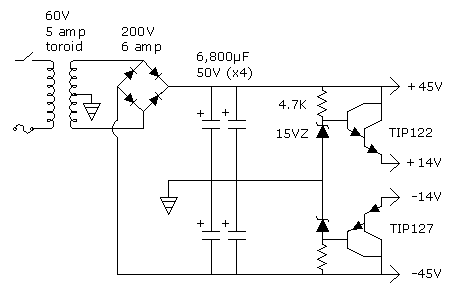 |
New Audio Amplifiers Bridge Amplifier A bridge amplifier produces about four times as much wattage from the same voltage as a regular amplifier. It does that by controlling both sides of the speaker instead of just one side. Regular amplifiers operate with one side of the speaker grounded; so only half of the power supply is being used at any time. The bridge amplifier applies that unusued voltage to the other side of the speaker. It does that with another amplifier which is inverted from the first. The voltages on the two sides of the speaker then move in opposite directions. The only advantage of the bridge amplifier is lower voltage. But that's enough of an advantage to justify it at high wattages, particularly since home builders cannot get parts for systems above 100V. Op amps can then be used at fairly high wattages. In the past, amplifiers were too difficult to produce to put twice as many in a box for bridging. Now they are easy enough to produce to make bridge amplifiers practical. |
|
|||||||||
   |
|
Power Supplies
Transformers produce a peak voltage of a little more than 1.4 times their rated voltage which is rms. The filtering capacitors capture the peak voltage; but that voltage drops rapidly to the rms level with a load. There is some ripple at the rms level, because filtering capacitors are not thorough at heavy loads. A typical ripple on the filtering capacitors would be 10 to 20% at full load. Oversize capacitors reduce the ripple somewhat. The capacitors should be atleast large enough to handle the current according to their ripple current ratings, which are given in some catalogues. Power Supply Circuits (watts per channel) 10 Watt Amplifier The bridge amplifier uses about the same power supply, except that two transformers are-paralled for doubling the amperage. The polarity must be watched when paralleling transformers. If in doubt, apply voltage and compare outputs. The 15,000µF filtering capacitors are a little larger than they would have to be. A size of 10,000µF would have been within specifications for the 4 amps of current. These two transformers produce a lot of heat, which is a problem for the bridge amplifier. I had to put fins on the sides of the lid for additional dissipation. For this reason, it would be preferrable to use a toroid transformer for the bridge amplifier. The 90V amplifier uses a toroid transformer (from Active Electronics). At high wattages, toroid transformers should be used, because they are far more efficient than rectangular transformers. A lot of transformer heat under the aluminum is not easy to handle; but here it is no problem. The toroids waste almost no energy with light loads; so using a high powered amplifier on a table top for quiet listening is very practical. Again, this transformer is a little underloaded; and the speakers see ±35V peaks with full load on both channels. The transformer load is a little more than 3 amps. So there is more than twice as much capacitor filtering as would have been required, unless parallel loading of the speakers increases the amperage. Voltage regulators are used for the light circuitry. They are set at ±8V for the op amps. Diodes then drop it to ±7.4V for the CMOs. Another 0.6V drop is used for the protection diodes infront of the first four CMOS switches. But instead of just using another diode on each side, which would have allowed the signal to pull against resistors, transistors buffered the ±6.8V, as shown. Ahead of the regulators, the voltage was dropped to ±l5V with transistor buffered zeners. The regulators could have handled the higher voltage; but the heat was reduced on them, because the lower one handles quite a bit of current for the LEDs. The drift on the regulators probably would not have precluded their use for setting the input current for the quad input amplifier. But since the regulators are adjustable, excessive or unwitting variations in the amplifier input current could have resulted; and therefore, zeners were used along with the regulators for the quad input amplifier. Shut Off Mechanism The on-off switch controls the ac line voltage; but not the dc. Therefore, the filtering caps are drained through a power resistor which is switched with the ac. Reverse diodes from supplies to ground protect against reverse voltage. Regulators are protected from reverse current with diodes, as shown; or the current can be drawn through their outputs. (Figure)
Headphones The headphone jacks were usuallly on the front panel. A switch near the speaker outputs allows the speakers to be turned off for headphone listening. An 1/8" stereo jack was used for the lightweight headphones; and a 1/4" stereo jack for regular headphones. |
|
|
Calculating Wattages. Almost all watts in electronics are converted to heat; and that heat has to be accounted for.
|
|





